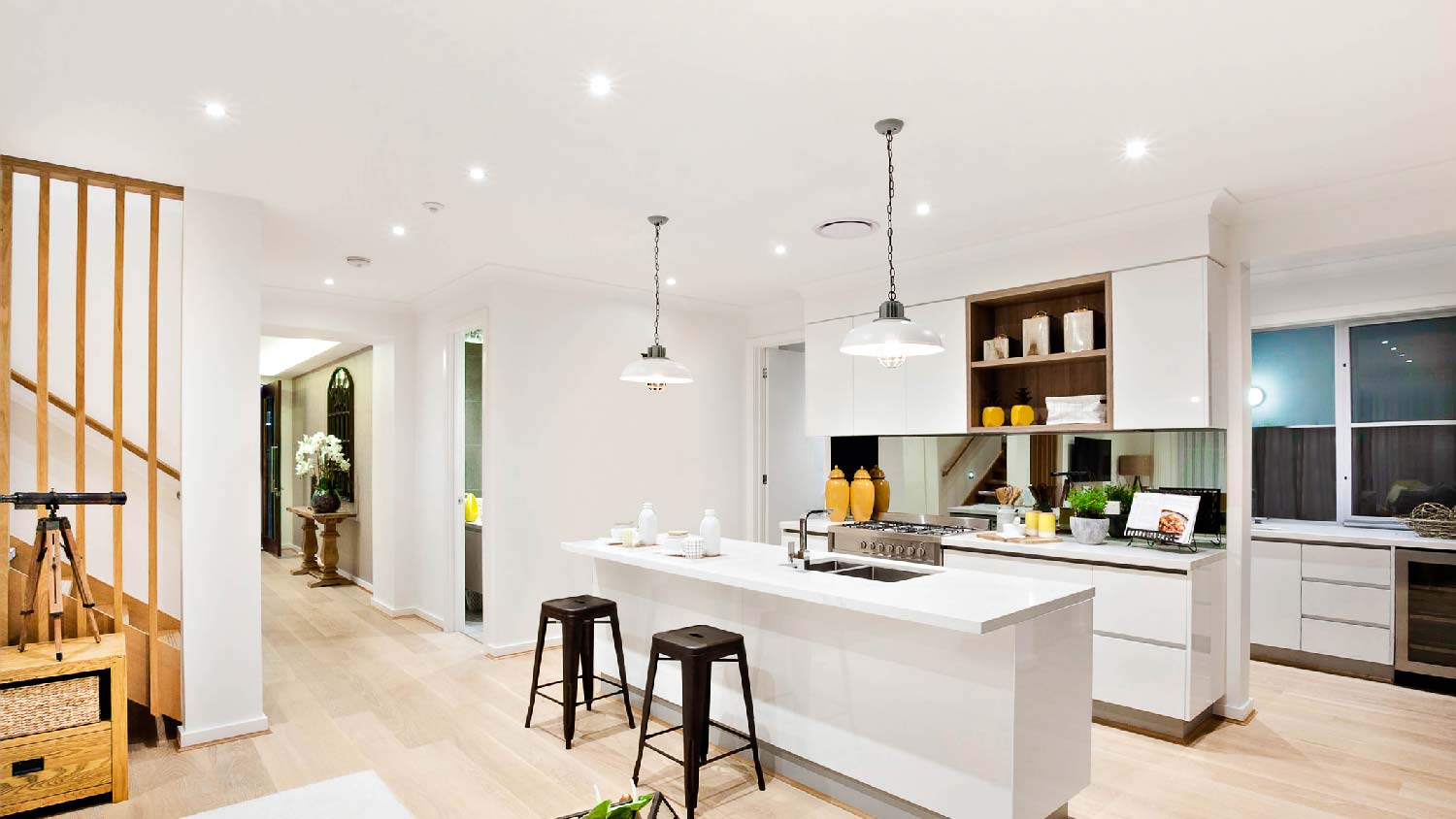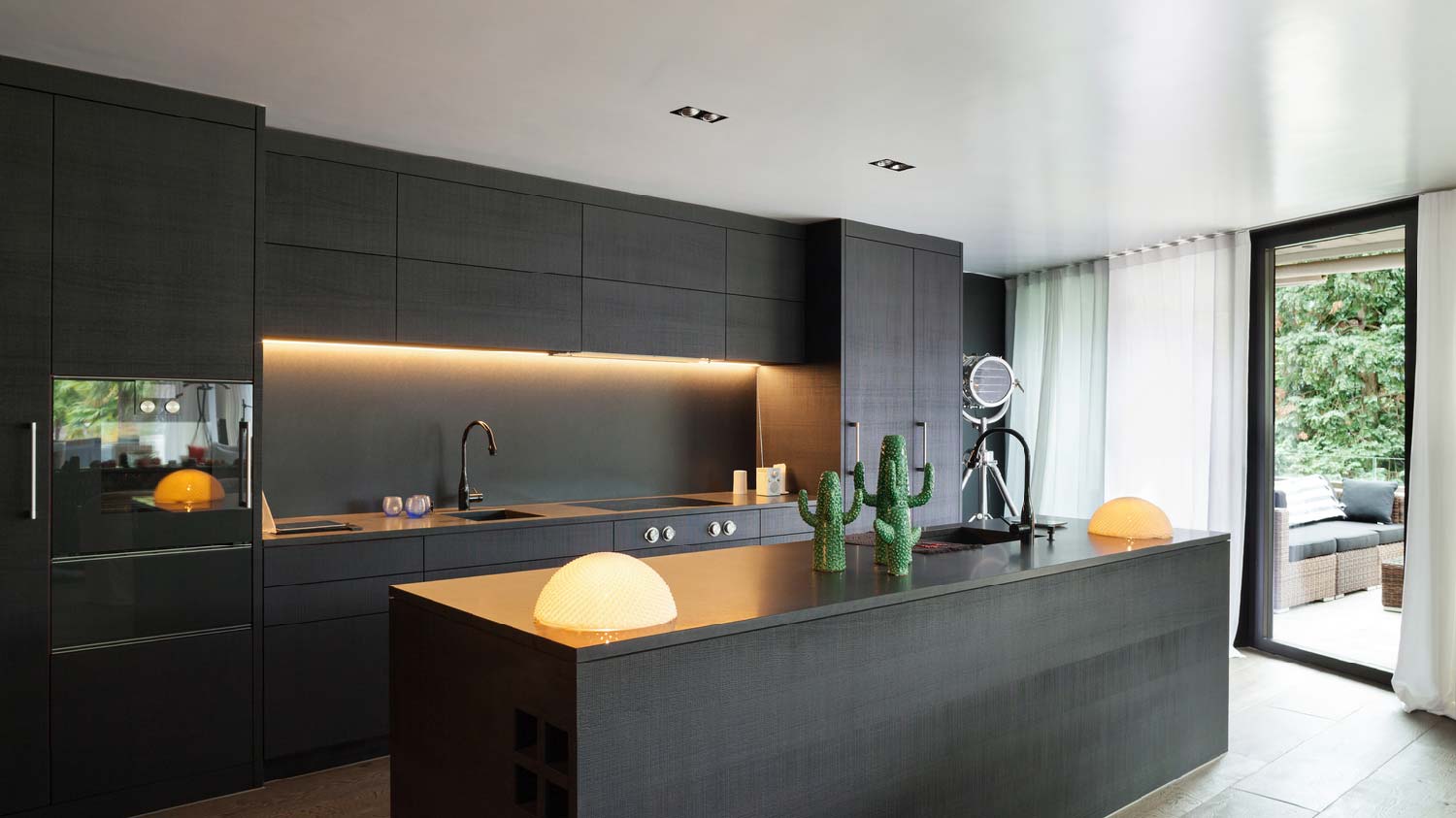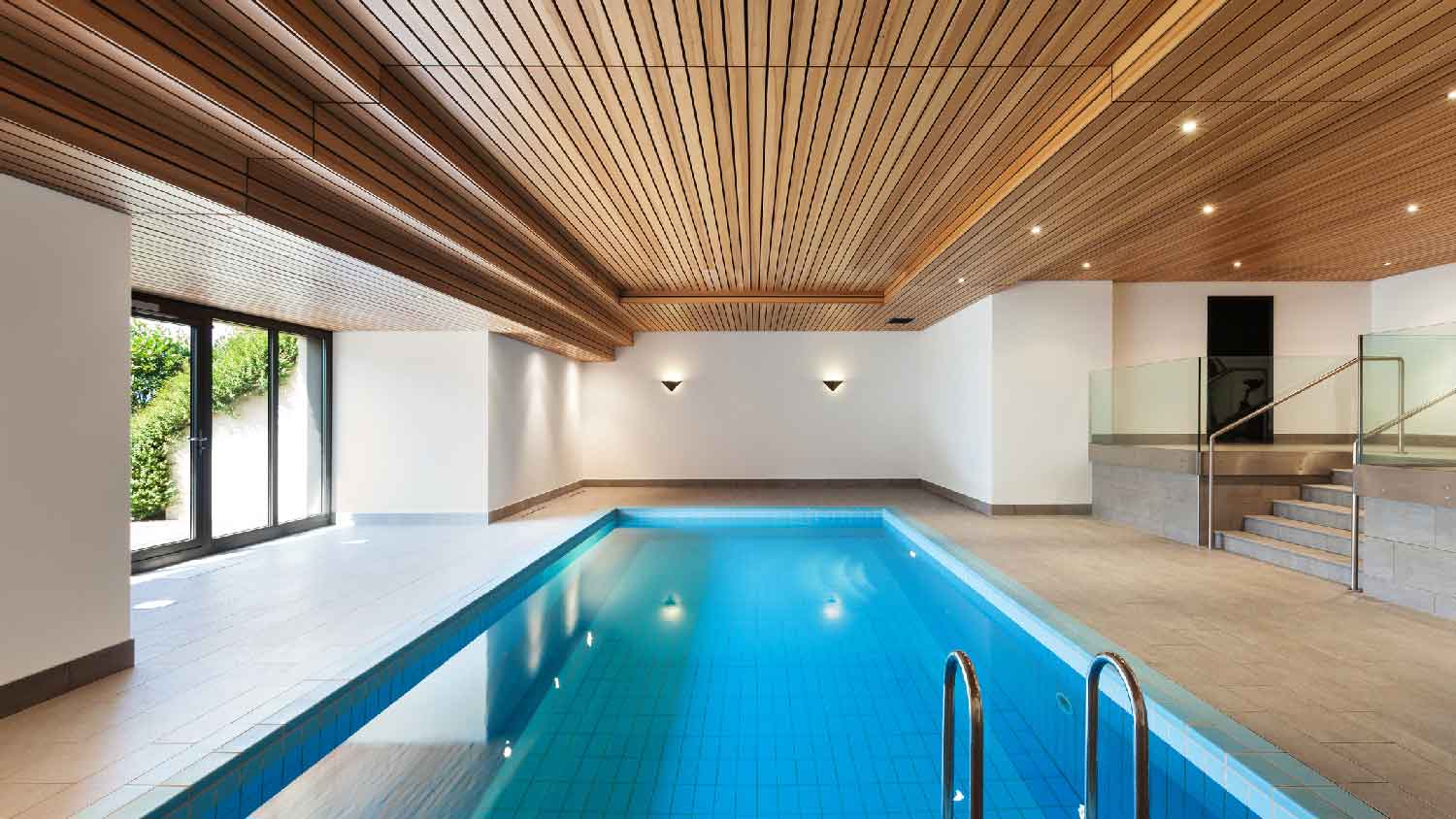How to Choose the Right Type of Recessed Lighting for Any Space
Join the recessed revolution


Recessed lighting offers homeowners a great way to illuminate their homes while taking up little overhead space. These fixtures that are installed directly into the ceiling provide lots of lighting without any worry of bumping your head. If you’re on the recessed lighting train and want to know more about the different types available, you’ve come to the right place!
Recessed lighting fixtures have three main components: the light bulb, the housing, and the trim. The trim is the main part that differentiates the various types of recessed lights from one another. With varying designs and features, each trim option offers a different purpose and is best suited for a certain type of illumination.
1. Open Trim
Open trim fits tightly around the lamp and is low profile. It appears exactly flush with the ceiling, which means you can’t see the interior of the fixture. Its design also allows for full illumination from the bulb without any blocks or restrictions. Open trim is one of the most cost-effective options, ranging from $5 to $90 per fixture.
| Pros | Cons |
|---|---|
| Cost-effective | Simple in design |
| Unrestricted illumination |
Best For: Those looking for a simple, low-budget option
2. Reflector Trim

Reflector trim has a mirrored surface inside the fixture, which helps to enhance the illumination. The recessed light bulb is inset and the light is amplified so it appears more vibrant and brighter. There are also some reflector trims that feature tinting. The cost of reflector trims ranges from $10 to $70 per fixture.
| Pros | Cons |
|---|---|
| Light appears vibrant | May be too bright |
| Polished & sleek look | Trim isn’t flush |
Best For: Kitchens or rooms with high ceilings that need amplified lighting
3. Baffle Trim
Baffle trim is one of the most common types of recessed lighting trim. It features a ribbed interior that helps to reduce glare and reflection from the recessed light bulbs. The soft glow of the light is ideal for reducing eye strain and providing calming ambient lighting.
Baffle trim is not flush with the ceiling, and the bulb sits in the interior of the fixture. The cost for baffle trim ranges from $5 to $80.
| Pros | Cons |
|---|---|
| Reduces glare | Not bright enough |
| Soft, calming glow | Trim isn’t flush |
Best For: Creating a soft glow in living rooms, entryways, and foyers
4. Pinhole Trim
With pinhole trim, the light bulb sits above the ceiling and shines through a small hole. This creates a narrow, tight beam of light that gives a modern look, and is an ideal choice for putting a spotlight on specific areas or objects. The cost of pinhole trim ranges from $15 to $80 per fixture.
| Pros | Cons |
|---|---|
| Creates a spotlight | Appears dark or cold |
| Modern appearance | Can’t light big room |
Best For: Adding a spotlight to a certain object or area
5. Eyeball Trim

Eyeball trim features a rounded bulb housing that can be tilted and rotated. It can be angled any way you choose, allowing you to focus the light on different areas. The range of motion for eyeball trim is typically 30-degree and 359-degree rotations. The cost of eyeball trim ranges from $15 to $90 per fixture.
| Pros | Cons |
|---|---|
| Can be adjusted | Trim isn’t flush |
| Rounded bulb tilts | Costly option |
Best For: Rooms where the focus of the light may need to be adjusted
6. Canless Trim
A canless recessed light is an all-in-one unit that plugs into your home’s electrical wiring. It does not require an electrical box or housing and has built-in trim. Canless lights are low-profile and can be used with a variety of design styles.
The unit typically has integrated LED light bulbs, which are more energy-efficient and longer-lasting than other bulbs. However, the whole fixture needs to be removed when the light bulb goes out. The cost range for these lights is $20 to $160 per fixture.
| Pros | Cons |
|---|---|
| One unit | Hard maintenance |
| Uses LED bulbs | Very expensive |
Best For: Those looking for an easy-to-install, all-in-one option
7. Gimbal Trim
Gimbal trim is similar to eyeball trim; however, the bulb is farther back in the ceiling. Where the rounded bulb of the eyeball trim sticks out from the ceiling, the bulb of a gimbal trim light is nearly flush.
It provides a direct, downward light source that can be adjusted to the spot of your choosing, but at some angles, the housing will block some of the light. The cost for gimbal trim ranges from $15 to $60.
| Pros | Cons |
|---|---|
| Can be adjusted | Blocked lighting |
| Flush with ceiling | Can’t light big room |
Best For: Adding direct downlight to accent walls or sloped ceilings
8. Wall-Wash Trim
Wall-wash trim has a shield that blocks half of the light. This helps to focus the rest of the light on a specific area or task. They are commonly used to put a spotlight on paintings or fireplaces.
Similar to gimbal trim, wall-wash trim can be rotated and angled to the direction of your choosing. The cost of wall-wash trim ranges from $10 to $100 per fixture.
| Pros | Cons |
|---|---|
| Adds a focused light | Blocked lighting |
| Can be angled | Can’t light big room |
Best For: Adding focused illumination to highlight an area or task
9. Shower Trim

Shower trim is made for use in wet locations. It has a tempered glass lens that protects the light bulb and keeps water out. They’re designed to be moisture and corrosion-resistant.
Shower trim features a simple, understated design that easily blends into your bathrooms. They’re often installed in the shower or above bathtubs. The price for shower trim ranges from $10 to $90.
| Pros | Cons |
|---|---|
| Moisture-resistant | Only for wet areas |
| Corrosion-resistant | Just for bathrooms |
| Watertight seal |
Best For: Illuminating your bathroom
Rest Easy With Your Recessed Lighting Choice
Deciding on the best recessed lighting for your space depends on the type of illumination you’re searching for. When it comes to brightening up a room, try:
Open trim
Reflector trim
Baffle trim
Canless trim
For focused spotlights, consider:
Pinball trim
Eyeball trim
Gimbal trim
Wall-wash Trim
When it comes to wet environments, shower trim is the way to go.
No matter the recessed lighting option you choose, consider calling a local light fixture technician near you to complete the installation. Installing recessed lighting yourself can be tricky and involves electrical knowledge. The pros are equipped with the knowledge and skills to get the job done easily and efficiently, and installation costs only run about $360.





- 7 Tips to Choose Tile Trim and Edging for Your Home
- What Is Recessed Lighting and How to Use It To Give Your Space a Modern, Minimalist Look
- How to Change a Recessed Light Bulb in 6 Steps
- 16 Exterior Window Trim Ideas and Styles to Make the Best First Impression
- Do You Paint Trim or Walls First in Your Room? How to Decide
- Best Paint for Trim and Baseboards: A Complete Guide
- 5 White Wall and Trim Color Combinations That Will Stun You With Every Glance
- Can vs. Canless Recessed Lighting: What’s the Best Choice for Your Home?
- Who to Hire to Install Recessed Lighting
- The Difference Between Can Lights vs. Recessed Lights and How To Make a Choice for Your Home










